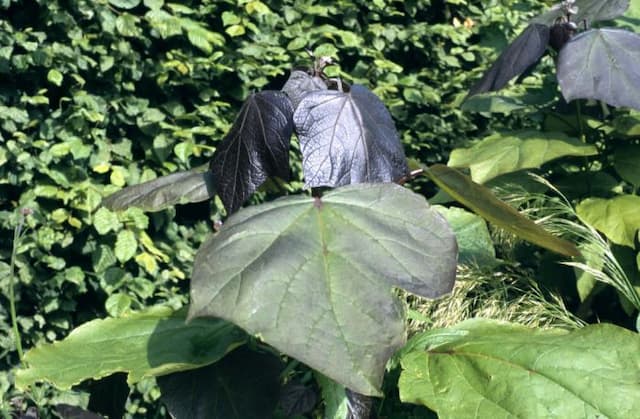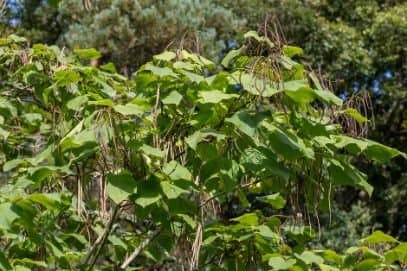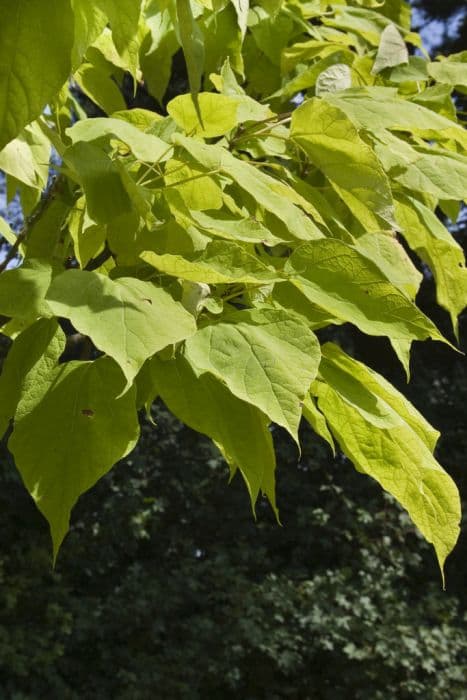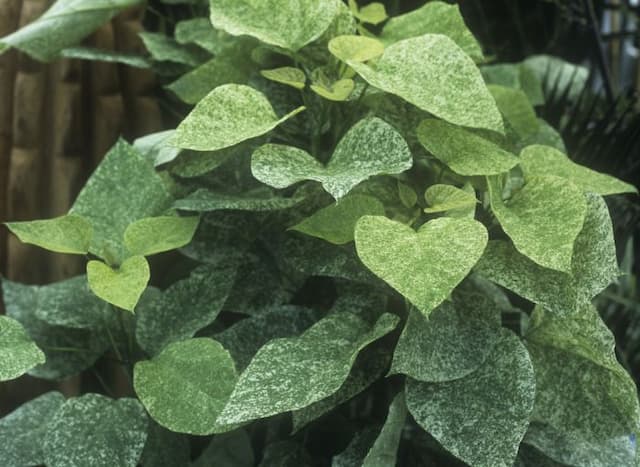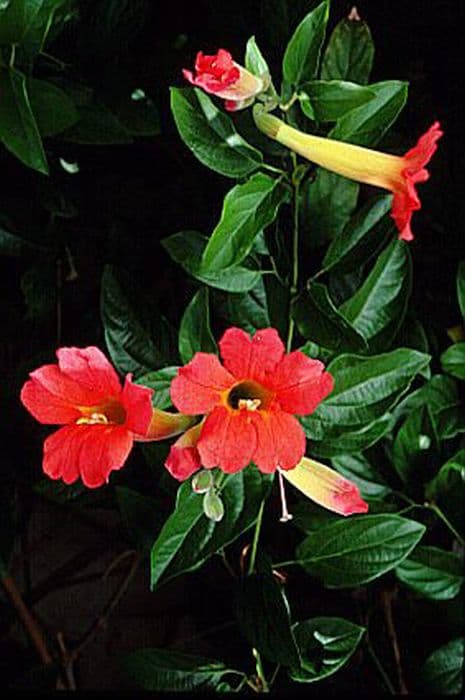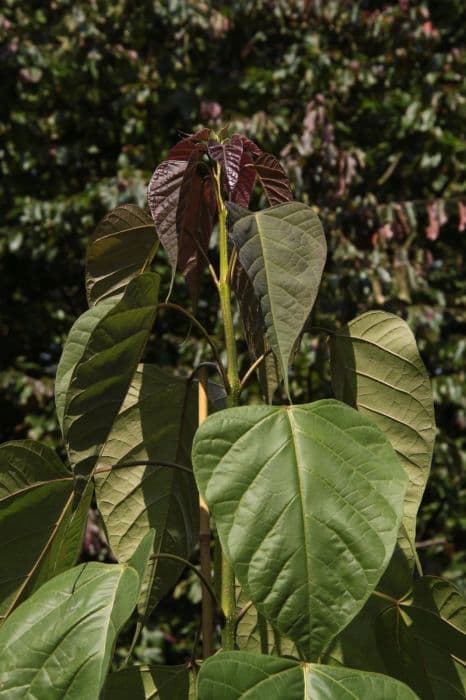Trumpet Vine Campsis × tagliabuana Indian Summer = 'Kudian' (PBR)

ABOUT
The Indian Summer Trumpet Vine is an attractive plant known for its showy and vibrant features. Its appealing appearance is characterized by a stunning display of large trumpet-shaped flowers, which boast a rich shade of orange with a velvety texture. These flowers are conspicuous and often serve as a magnet for hummingbirds and other pollinators. The foliage of the Indian Summer Trumpet Vine is equally impressive, featuring glossy, dark green leaves that provide a lush backdrop for the bright flowers. The leaves are pinnately compound, giving them an elegant, fern-like structure that adds to the plant's ornamental value. As the seasons change, so does the appearance of the leaves, with some foliage possibly taking on subtle autumnal hues before falling off. The vine has a robust and vigorous growth habit, which allows it to produce an abundance of flowers throughout its blooming season, typically in the warmer months. It has the capacity to climb and spread, often using aerial roots to latch onto supports, making it a favorite for covering trellises, fences, and walls with a tapestry of color and verdure. The visual impact of the Indian Summer Trumpet Vine is a result of both its floriferous nature and its lush greenery, making it a popular choice for gardeners looking to add a splash of warmth and vitality to their outdoor spaces.
About this plant
 Names
NamesFamily
Bignoniaceae
Synonyms
Trumpet Vine, Trumpet Creeper, Common Trumpet Creeper, Cow Itch Vine, Hummingbird Vine
Common names
Campsis × tagliabuana Indian Summer = 'Kudian' (PBR).
 Toxicity
ToxicityTo humans
The Trumpet Vine (common name for Campsis × tagliabuana) is not generally considered toxic to humans. However, it's always best to be cautious and avoid ingesting any part of ornamental plants as they are not intended for consumption. In rare cases, sensitive individuals might experience gastrointestinal discomfort if parts of the plant are ingested.
To pets
The Trumpet Vine is also not generally known to be toxic to pets. However, if a pet were to consume a large amount of the plant, it might experience mild gastrointestinal upset such as vomiting or diarrhea due to the non-digestible nature of the plant material. Always keep an eye on your pets and prevent them from eating ornamental plants to avoid any potential issues.
 Characteristics
CharacteristicsLife cycle
Perennials
Foliage type
Deciduous
Color of leaves
Green
Flower color
Orange
Height
15 feet (4.5 meters)
Spread
10 feet (3 meters)
Plant type
Climber
Hardiness zones
6
Native area
Hybrid
Benefits
 General Benefits
General Benefits- Vigorous Growth: The plant exhibits a fast-growing nature, making it suitable for quickly covering trellises, arbors, and walls.
- Showy Flowers: It produces striking trumpet-shaped orange to red flowers that add a splash of vibrant color to the landscape.
- Drought Tolerance: Once established, it has a good tolerance to drought, reducing the need for frequent watering.
- Low Maintenance: It requires minimal care once established, other than pruning to control its growth and shape.
- Attracts Wildlife: The flowers are attractive to hummingbirds and butterflies, providing a benefit to the local ecosystem.
- Long Flowering Season: It boasts a long blooming period from summer to fall, which enhances garden interest for an extended time.
- Adaptable: Campsis × tagliabuana 'Indian Summer' is adaptable to a variety of soil types, though it prefers well-drained soils.
- Hardy: This cultivar is relatively hardy and can withstand colder temperatures once well-established.
 Medical Properties
Medical PropertiesThis plant is not used for medical purposes.
 Air-purifying Qualities
Air-purifying QualitiesThis plant is not specifically known for air purifying qualities.
 Other Uses
Other Uses- Sound Barrier: The dense foliage of Campsis × tagliabuana Indian Summer can be used to create a natural sound barrier to dampen traffic noise in urban gardens.
- Fabric Dye: The flowers and leaves can potentially be boiled to create a natural dye for fabrics, offering hues in the yellow to green spectrum.
- Insect Shelter: The plant's structure provides a habitat for beneficial insects and can be integrated into pest management strategies in gardens.
- Photography: The vibrant orange flowers make Campsis × tagliabuana Indian Summer a popular subject for nature photographers, contributing to artistic projects.
- Educational Use: This plant can be used in educational settings to teach about plant hybridization and ornamental horticulture principles.
- Screen Printing: The unique shapes of the leaves can be used in screen printing to create botanical patterns on paper or textiles.
- Seasonal Festivities: The stunning flowers can be incorporated into festive decorations during autumn celebrations due to their warm color.
- Soil Erosion Control: The plant's extensive root system can help stabilize soil on slopes and prevent erosion in hilly landscapes.
- Support for Climbing Plants: Campsis × tagliabuana Indian Summer can serve as a living trellis for other climbing plants that might need support.
- Play Structure: With supervision, the sturdy vines and branches can be creatively used as part of natural play structures for children.
Interesting Facts
 Feng Shui
Feng ShuiTrumpet vine is not used in Feng Shui practice.
 Zodiac Sign Compitability
Zodiac Sign CompitabilityTrumpet vine is not used in astrology practice.
 Plant Symbolism
Plant Symbolism- Passion: The vibrant, trumpet-shaped flowers of the Trumpet Vine 'Indian Summer' often symbolize deep passion and attraction, possibly due to their bold color and shape which resembles a horn used to herald significant events.
- Growth and Vitality: The vigorous growth habit of the Trumpet Vine is symbolic of robust vitality and relentless life force, easily covering structures and landscapes if given the chance.
- Attraction: With its warm, orange flowers, Trumpet Vine 'Indian Summer' is often associated with attraction, not just in the romantic sense, but also attracting attention and interest due to its showy appearance.
- Support: As a climbing plant, Trumpet Vine may symbolize the idea of support and reliance, needing something strong to grow upon—this could represent the idea of community or partnership.
 Water
WaterThe Trumpet Vine 'Indian Summer' requires regular watering, especially during prolonged dry spells. Water this plant deeply once a week, providing approximately 1-2 gallons per watering session, ensuring the soil is thoroughly moistened. Increase the frequency of watering during hot or windy weather, but allow the soil to dry slightly between waterings to prevent over-watering and potential root rot. During the winter months, reduce watering as the plant enters dormancy and requires less moisture.
 Light
LightTrumpet Vine 'Indian Summer' thrives in full sun to part shade. The ideal spot for this plant is an area where it can receive at least 6 hours of direct sunlight daily. However, it can also tolerate some light shade, especially in hotter climates where some respite from the intense afternoon sun can be beneficial.
 Temperature
TemperatureThe Trumpet Vine 'Indian Summer' is hardy and can tolerate a wide range of temperatures, from as low as 30°F to as high as 90°F. The ideal temperature range for this plant is between 60°F and 80°F. Extreme temperatures below freezing may damage the plant, so provide protection if temperatures are expected to plummet.
 Pruning
PruningPruning of Trumpet Vine 'Indian Summer' is important to control its growth and encourage more flowering. Prune in late winter or early spring before new growth starts. Remove any dead or damaged wood and cut back the previous year's growth to 2-3 buds per stem to shape the plant and ensure it puts energy into producing new flowers. Pruning can be done annually to maintain the preferred size and shape.
 Cleaning
CleaningAs needed
 Soil
SoilThe Trumpet Vine 'Indian Summer' thrives in well-draining soil with a pH range from 6.0 to 7.0. A good soil mix is one part peat, one part perlite, and two parts loam. Ensure proper nutrients by incorporating compost or a balanced slow-release fertilizer into the mix.
 Repotting
RepottingThe Trumpet Vine 'Indian Summer' should be repotted every 2 to 3 years to prevent it from becoming root-bound. It is best done in late winter or early spring before new growth begins.
 Humidity & Misting
Humidity & MistingTrumpet Vine 'Indian Summer' is tolerant of a wide range of humidity levels but prefers average air moisture. It does not require any specific humidity adjustments when grown outdoors.
 Suitable locations
Suitable locationsIndoor
Place in bright indirect light, keep soil moderately moist.
Outdoor
Plant in sunny spot, ensure soil drainage, water regularly.
Hardiness zone
5-9 USDA
 Life cycle
Life cycleCampsis × tagliabuana 'Indian Summer', commonly known as Trumpet Vine, starts its life cycle as a seed, which germinates in the spring under adequate temperature and moisture conditions. Upon sprouting, the seedling rapidly grows into a vigorous vine, featuring compound leaves and a woody stem structure. As the vine matures, usually within a few years, it enters the flowering stage during the summer months, producing clusters of trumpet-shaped, orange to red blooms that attract pollinators. After pollination, the flowers develop into elongated seed pods that eventually dry and release seeds to complete the reproductive cycle. The plant enters a period of dormancy during the winter, losing its leaves in colder climates, but it can remain evergreen in milder zones. With proper care and conditions, the Trumpet Vine can live and thrive for many years, often growing aggressively if not properly managed.
 Propogation
PropogationPropogation time
Spring-early summer
The Trumpet Vine 'Indian Summer', often propagated in spring to early summer, is most commonly reproduced through softwood cuttings, a method in which new plants are grown from sections of stem that have yet to become hard and woody. To propagate by cuttings, a 4 to 6-inch (10 to 15 cm) stem section with several leaves is cut just below a node, where the leaf attaches to the stem. The lower leaves are removed, and the cut end may be dipped in rooting hormone powder to improve success rates. The prepared cutting is then placed in a well-draining potting mix and kept moist until roots develop. To maintain high humidity around the cutting, a plastic bag or cover can be used, with ventilation provided to prevent excessive moisture and mold growth. Roots typically form in a few weeks, after which the new plant can be transferred to a larger pot or directly into the garden soil.
